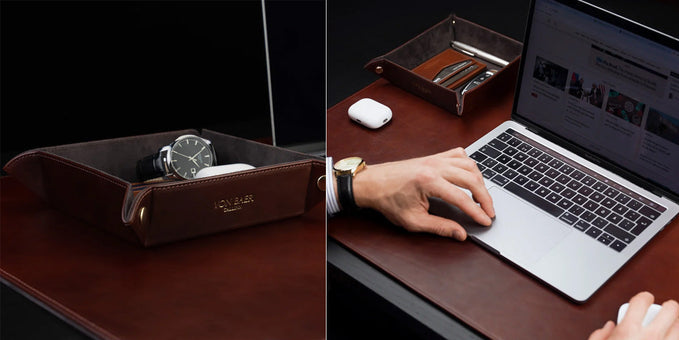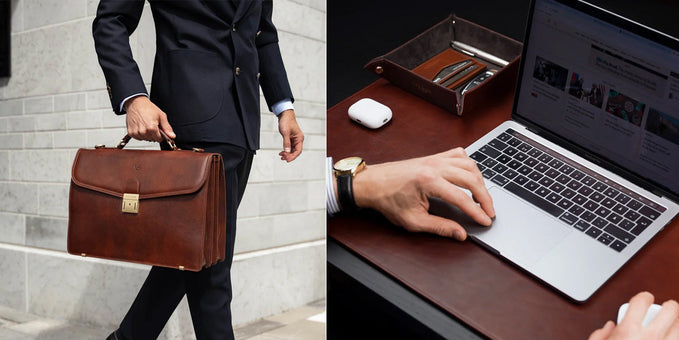What Do Lawyers Wear To Court?

For Female Attorneys:
- Wear structured suits or tailored dresses with a blazer in black, navy, or gray.
- Pair with low heels and a structured, zippered handbag or tote.
- Avoid sleeveless tops worn alone, loud accessories, or shiny fabrics.
- Prioritize fit, comfort, and modest layering for a confident, professional appearance.
For Male Attorneys:
- Choose a dark wool suit with a crisp dress shirt and subtle tie.
- Wear polished leather shoes and carry a clean, structured briefcase.
- Avoid trendy cuts, flashy fabrics, or oversized accessories.
- Focus on classic fit, restraint, and details that project calm authority.
Here are more details:
For Women: How to Avoid Courtroom Clothing That Undermines Your Presence
Say Goodbye to “Business Casual” - Say Hello to Structured Respect
Let’s be real: “business casual” is a moving target. What flies in the HR department of a startup will absolutely torpedo your credibility in court. And no, your professor’s blazer-from-college look won’t cut it here either.
Courtroom dressing is less Pinterest, more chessboard.



Every piece needs structure - literally and figuratively. Not just because you want to look the part, but because courtrooms are physically demanding.
You're seated for hours on benches that slope backwards. You're getting up to hand over exhibits, walking past jurors, making eye contact with judges.
Your clothes need to endure a full day of scrutiny and still sit smooth at 4:45 p.m. when the docket finally clears.
Instead of just “wearing a suit,” think in layers of purpose:
- Choose heavier fabrics - 8 to 10 oz wool per yard or ponte blends. Why? They don’t crumple when you sit. They fall back into place when you stand. Light rayon? That’ll wrinkle before your first sidebar.
- Go for lapels at least 3 inches wide. Wider says poise. Narrow lapels read as fast fashion.
- Opt for full lining (acetate or polyester), especially in jackets. That extra layer smooths your shape and minimizes cling, especially under courthouse AC vents.
- Shells or sleeveless blouses with bonded seams eliminate show-through lines under blazers. You want the judge watching your cross - not your collar warping mid-argument. (But remember: sleeveless tops must always be worn with a jacket in court - courts like the Bankruptcy Court have rules against sleeveless or cap sleeve dresses worn alone.)
- And remember that reach test? Try handing a legal pad across a table. If anything rides, tugs, or bunches - you’ve just found your weak spot.


Essentials for Your Courtroom Closet:
- Single-breasted blazers with at least one interior pocket. (Where else will you stash a pen when your hands are full of files? Bonus: Some courts are strict about bringing bags. Pockets matter.)
- Mid-rise trousers (9-11 inch front rise, 30-32 inch inseam). High-waisted can twist uncomfortably when seated.
- Pencil skirts, 23-25 inches long, ideally with a deep kick vent - because rushing up courthouse steps in a narrow skirt is a sport no one trains for.
- Moisture-wicking tops (150 gsm+). You don’t want pit stains mid-motion argument.
- Pumps between 1.25-2 inches with rubber soles. Your shoes should support you during a 9-hour docket and not echo like a horror movie hallway.
- 14-16 inch leather tote, structured base at 4 inches wide, with top zip. Not a beach bag. Not a yoga sling. Something that stands upright when you place it on the bench next to you.
Your clothing doesn’t need to “say something.” It needs to confirm everything you’ve earned so far.
Strong pieces fall apart fast if the small stuff betrays you. Let’s talk about the things that really get noticed.
Small Errors That Cost You Authority
Nobody pulls you aside and says, “Your outfit made that judge pause.” But it happens. A slightly sheer blouse under LED lighting. A too-loud necklace. A low heel that makes noise every time you cross the aisle.
Think of court as Harvard Law’s version of Shark Tank. Judges, jurors, partners - they’re all watching. Not always consciously. But they’ll remember if something doesn’t feel “right.”
The details matter because they tell a story, even when you’re silent.
Let’s break it down:
- Satin is fine in a lining. On the outside? It’s clubwear under court fluorescents.
- Many off-the-rack shirts don’t fit at the bust. You’ll find out mid-deposition when you lean forward and your button gapes. Opt for hidden plackets or shirts with 5 percent spandex blends.
- Earrings bigger than 6mm? Distracting. Save hoops and dangles for post-trial drinks.
- Hair should not become a habit. That one time you tuck it behind your ear in front of the judge? You just undermined your command.
- Sheer-looking fleece-lined tights are a pro move in cold courtrooms. They look like standard black tights but keep you warm - without looking like you’re wearing thermal underwear.
Imagine you're arguing in front of Sonia Sotomayor. Would you risk a rogue hair flip or squeaky shoes in that room?
We have a more detailed guide on outfit ideas for female lawyers here.
For Men: Why Just Owning a Suit Doesn’t Mean You’re Dressed for Court



You’re Not a Best Man - So Don’t Dress Like One
Here’s the trap: You buy a decent suit. It fits. It’s charcoal or navy. Done, right?
Not even close.
A court-appropriate suit has nothing to do with “looking good.” It’s about eliminating any thought that you’re not ready. A too-shiny tie. A trendy cut. Unbroken-in shoes that squeak every time you stand. These are silent cues that scream rookie.
Judges can smell it. Bailiffs have seen it. Senior partners might chuckle later (but won’t tell you why your client didn't take you seriously).
Don’t look like you just came from your cousin’s wedding in Miami. Look like you’ve been arguing suppression motions since 9 a.m.
Watch for:
-
Fabric sheen above 20 percent? Flashy.
-
Tie width below 2.75 inches or above 3.25 inches? Wrong era.
-
Trousers that bunch over your shoes? That’s not tailored - that’s tired.
Court isn’t casual Friday at Kirkland & Ellis. It’s Tuesday morning in Bronx Criminal Court, and someone just got cuffed outside the elevator.
Let’s build a courtroom suit of armor that gets you through bar appearances, arraignments, and closing arguments - without a single stitch letting you down.
Anchor Yourself With These Proven Courtroom Standards



Buy one suit. Tailor it perfectly. Wear it like it’s part of your operating system.
Don’t chase variety. Chase unshakeable consistency.
Deeper criteria for each piece:
- Suit fabric: 100 percent wool or blend. Super 100s-120s. No shine. Fabric should drape, not cling or crumple.
- Shirt collar height: 1.5 inches minimum. Anything less and it disappears under the lapel.
- Trousers: 9.5-11 inch rise, 2 inch hem allowance, 1.5 inch cuff-to-ground the leg line.
- Tie bar: 1.25-1.5 inch max. Anything longer and you look like you stole it from your dad.
- Shoes: Oxfords, cap toe, Goodyear welted. Cost per wear beats fast fashion - Allen Edmonds can last 10 years if cared for.
- Facial hair? Line it. Keep it under 0.5 inch length. You want controlled, not creative.
Real courtroom prep trick: Sit in that suit. For 30 minutes. At a desk. On a bench. Cross your legs. Lean over a padfolio. Does your jacket ride up? Do your buttons strain? That’s your tailoring litmus test.
The best suit is the one no one notices - because it fits like a law degree.
We have a more detailed guide on lawyer outfit ideas for men here, and best suits for lawyers here.
With the armor in place, the next battle is in the accessories. And this is where most new pros self-sabotage.
Final Touches That Signal Competence Before You Speak

How to Send Authority Signals With Accessories and Grooming
You’ve seen the type: Clean suit, clean shave...and a JanSport backpack. Or a tote bag with a Bar Exam Survivor sticker on it. Or a smartwatch that lights up mid-bench conference.
It’s not a small thing. Accessories speak louder than you think.
Courtroom pros - especially the ones who spent time clerking - know this: the fewer movements you have to make, the better. The less visual clutter you carry, the more the court sees you. Not your stuff.
Here’s what you need to clean up your presence:
- Analog watches only. Nothing over 1.2 inch diameter. Courtrooms hate distractions.
- Zipped or structured bags only. No fobs. No stickers. No soft sides. You want a bag that sits up, opens wide, and closes fast. We recommend high quality full-grain leather bags for lawyers (like these), and you can see more info on what bags lawyers should wear here.
- Blue ink pens only. Ballpoint or fine tip. Pilot G2. Uni-ball Vision. Smooth lines. Professional signatures.
- Leather padfolio or 9x12 notebook. Never spiral. Never loose leaf. Judges notice who rustles paper and who doesn’t.
- Oil blotting wipes. You might not sweat, but courts are cold for men, colder for women. Bring fleece-lined tights or anti-shine wipes - not thermals or powder compacts.
Imagine you're walking into the Southern District of New York. You pass the eagle plaque. Your bag flops over. Your pen leaks. That’s not a detail - it’s a memory someone else will have.
Worried if lawyers still use a briefcase? See this guide.
Okay, you’re dialed in. Where do you actually buy this stuff without setting your bank account on fire?
Where to Find Court-Ready Style Without Going Broke

Law doesn’t need you to look like GQ or Vogue. It needs you to look like you’re ready for a motion to suppress at 8 a.m., and a second chair role at 1 p.m. Only a handful of brands really get that balance right.
Women’s Smart Picks:
- M.M.LaFleur: $300-$400 blazers that move like yoga jackets. Internal cell pockets and travel-ready stretch. Think: Harvard Law meets Drybar polish.
- The Fold: European fit. Hidden vents. High armholes. Perfect for long arguments at appellate level.
- Ann Taylor: $140 suits that pass for $300 if tailored. Great for your first 1L internship.
- Argent: Badge clips, stretch panels, washable suits. Literally designed by women who’ve clerked.
- Brooks Brothers: Still the East Coast classic for courtrooms with dark wood panels and even darker traditions.
Men’s Reliable Go-Tos:
- SuitSupply: $399 gets you courtroom-ready. Ask for their Napoli or Lazio fits - tailored but not tight.
- Charles Tyrwhitt: Dress shirts with reinforced seams. You can iron them once and wear them all week.
- Allen Edmonds: Buy once. Wear forever. Break them in 6-8 hours before court.
- Banana Republic Signature Line: Lightweight wool suits that don’t wrinkle walking from subway to courtroom.
- J.Crew Ludlow: Lean cuts with tailoring potential. Go charcoal or navy - never light grey, never linen.
Clothes can’t win your case - but they’ll sure keep anyone from questioning if you’re ready to try one.
Read next: What do lawyers wear?

Author: Igor Monte
Igor Monte is the co-founder of Von Baer. He's an expert in all things premium leather, from being an end-user right up to the design and manufacturing process. His inside knowledge will help you choose the best leather product for you.
We strive for the highest editorial standards, and to only publish accurate information on our website.
Leave a Comment
Your email address will not be published.






